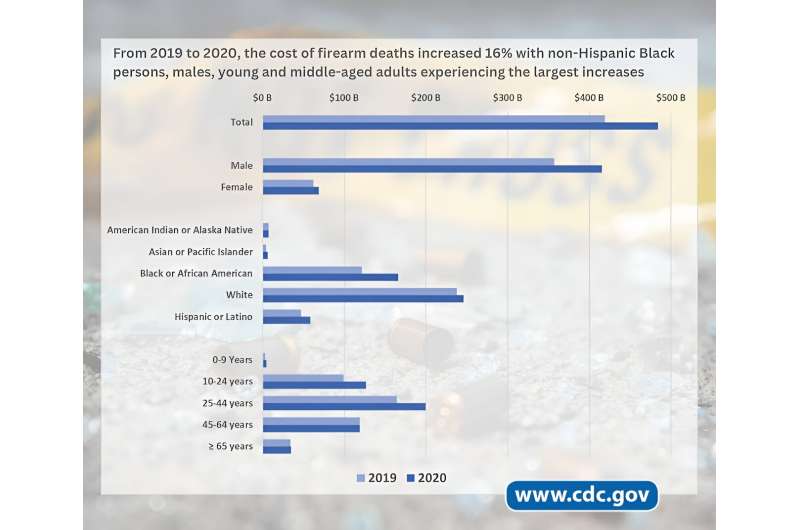This article has been reviewed according to Science X's editorial process and policies. Editors have highlighted the following attributes while ensuring the content's credibility:
fact-checked
peer-reviewed publication
trusted source
proofread
New research documents the rising economic burden of US firearm injuries and deaths

The economic impact of fatal and nonfatal firearm injuries in the United States increased by 16% in 2020 compared with 2019, according to new research reported in the American Journal of Preventive Medicine. The study also provides evidence of significant disparities in costs associated with firearm deaths in 2019−2020, with non-Hispanic Black individuals, males, and young and middle-aged groups being most affected, along with those who reside in urban areas and the South.
Firearm-related injuries are among the five leading causes of death for people one to 44 years of age in the United States. These fatal and nonfatal injuries take a human toll on individuals, families, and communities—and come at a high economic cost to the nation.
Investigators at the US Centers for Disease Control and Prevention (CDC) analyzed data from the following data sources to provide estimates of the economic burden of fatal and nonfatal firearm injuries in the United States in 2020: 2019−2020 Healthcare Cost and Utilization Project (HCUP) Nationwide Emergency Department Sample (NEDS) database, the most recent data available; and the 2019−2020 multiple cause-of-death mortality data from the restricted-use National Vital Statistics System (NVSS). The majority of nonfatal costs are attributed to hospitalization, while fatal costs are largely attributable to value of lives lost. Previous estimates have not included person-specific measures like lost quality of life and lives lost, which heavily impact the economic burden.
Lead investigator, Gabrielle F. Miller, Health Scientist, National Center for Injury Prevention and Control at CDC, Atlanta, elaborated, "The bulk of the costs associated with firearm injuries across all demographic and geographic categories does not come from the medical costs, but rather from lost quality of life and lives lost."
Key findings from this analysis include:
James A. Mercy, Ph.D., Director, Division of Violence Prevention, CDC, Atlanta, added, "The human toll of firearm injuries and deaths in our nation is vast and cannot be fully captured by these economic costs. Nevertheless, these costs are a valuable tool for measuring the economic benefit of the many strategies available that work to prevent firearm deaths and injuries."
Interventions and preventive measures include reducing access to lethal means among individuals at risk of harming themselves or others, strengthening economic supports and access to health and mental health care, education, and social services, and addressing systemic and structural inequities.
Dr. Miller noted, "Continued prevention efforts can reduce the costs to our society and ease the risks and inequities of the costs associated with firearm injuries and deaths."
CDC investigates injuries and violence to find the best ways to prevent firearm violence and suicide, applying science and creating real-world solutions to keep people safe, healthy, and productive. Understanding the economic burden that the immediate and long-term harms of firearm injuries pose on society tells us about the impact of injury prevention.
More information: Gabrielle F. Miller et al, Costs of Fatal and Nonfatal Firearm Injuries in the U.S., 2019 and 2020, American Journal of Preventive Medicine (2023). DOI: 10.1016/j.amepre.2023.09.026





















